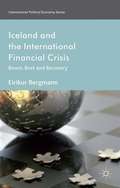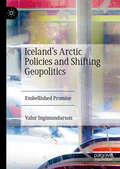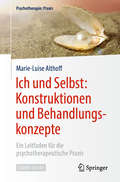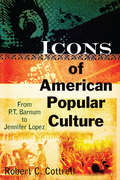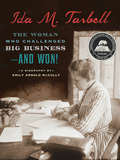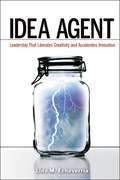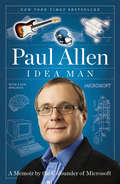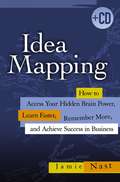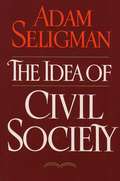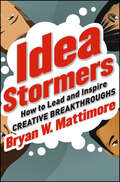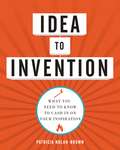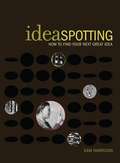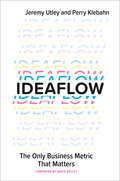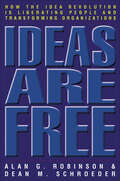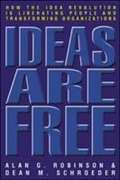- Table View
- List View
Iceland (B): Redefining Aaa-Rated Sovereigns
by Aldo MusacchioIn May of 2008, a team of sovereign debt analysts at Moody's had to decide whether to downgrade the country's sovereign long-term debt from Aaa to Aa1 or lower. Investor sentiment toward Iceland had changed radically in March, and the Moody's team was fearful that the situation could spiral out of control. The Moody's team knew that carry traders increased Iceland's vulnerability to a confidence crisis because they were quick to liquidate their holdings at the first sign of distress. The plunge in the Icelandic Krona since the beginning of 2008 also forced the Icelandic people to confront a decision: would joining the European Union (EU) protect Iceland from capricious swings in investor sentiment? What, if anything, should Iceland do to avoid a future crisis?
Iceland and the International Financial Crisis
by Eirikur BergmannEirikur Bergmann explains the exceptional case of Iceland's fantastical boom, bust and rapid recovery after the Crash of 2008 and explores the lessons for the wider EU crisis and for over-reaching economies that over-rely on financial markets.
Iceland’s Arctic Policies and Shifting Geopolitics: Embellished Promise
by Valur IngimundarsonThis book examines the role of the Arctic in Iceland’s foreign and security policies from the end of the Cold War to the present. Based on extensive research and drawing on approaches from the fields of history and international relations, it shows that Iceland’s Arctic policies have gone through multiple phases during this period, all of which have been heavily influenced by external geopolitical factors, including its relationship with the United States, the 2008 financial crisis, the rise of China, and the Ukrainian crisis. It also demonstrates how Iceland’s strategic position in the North Atlantic has important repercussions for the United States, Russia and China. With an emphasis on geopolitics, nation branding, and governance, this book will appeal to scholars and students of Arctic policies, geopolitics and international relations.
Ich und Selbst: Ein Leitfaden für die psychotherapeutische Praxis (Psychotherapie: Praxis)
by Marie-Luise AlthoffDieses Buch hilft Psychotherapeuten, Psychiatern und Supervisoren, ihre Patienten und Klienten bei ihrer Identitätssuche und Selbstfindung zu unterstützen. Als Ausgangspunkt der Überlegungen werden die Theorien der Ich- und selbstpsychologischen sowie der relationalen psychodynamischen Richtungen dargestellt. Die Selbst- und Identitätsbildung als Suchbewegung von Klienten und Therapeuten steht im Zentrum der Fragestellungen. Die Autorin gibt fundierte und hilfreiche Antworten – in dem Wissen, dass Antworten nie ein für alle Mal gelten und doch zufriedenstellend sein können. Wir transformieren uns fortwährend und können uns letztlich nie auf etwas Eigentliches zurückführen. Fragen aus dem Inhalt: Menschen sagen: „Ich suche mich“, „Ich finde mich“, „Ich erfinde mich neu.“ Wer oder was ist eigentlich dieses Ich, wer oder was ist dieses Mich, und was machen die beiden da, wenn sie sich suchen, finden oder erfinden? Machen die beiden das stets und ständig und beeinflussen sie sich wechselseitig? „Ich kann mich selbst so schwer verstehen?“ Wer oder was ist denn dieses Selbst? Also ist da noch ein Dritter im Bunde, wie immer? In diesem Buch werden Antworten auf diese Fragen gesucht. Die Autorin: Dr. phil. Marie-Luise Althoff ist Analytikerin, Dozentin, Supervisorin und Lehrtherapeutin und diskutiert mit Blick auf Psychotherapie und Supervision die Konzeptualisierung einer Beeinflussung des Ich- und Selbsterlebens.
Ich und die Anderen: Der Einfluss von Selbst- und Fremdbildern auf den beruflichen Alltag (essentials)
by Antje PfabDer Umgang mit anderen Menschen ist geprägt von der eigenen Selbst- und Fremdwahrnehmung. Berufliches Handeln wird von idealen Selbstbildern beeinflusst und kann zu Missverständnissen und Konflikten führen, wenn dieses Bild nicht mit dem Bild Anderer übereinstimmt. Die Autorin erklärt, wie menschliche Wahrnehmung funktioniert, Selbst- und Fremdbilder gebildet werden und welche Rolle die eigene Kultur dabei spielt. Sie gibt Anregungen zu einem bewussteren Umgang mit Selbst- und Fremdbildern.
Iconic Hollywood Dishes, Drinks & Desserts (American Palate)
by Amy BizzarriRecipes born in the city of starsLos Angeles is a city where film mingles with food. From healthful salads to sweet treats inspired by California's agricultural bounty, the innovative fare mirrors the rise from a sleepy, western outpost to celluloid dream, where food has always played an award-winning role. The minds behind these delicious treasures include a pauper who reinvented himself as a prince, a penniless single mom who perfected a treasured recipe to create an empire, and a guru who provided good vibes and scandal alongside cold-pressed juices. Bake up the Cocoanut Grove's Coconut Strawberry Cream Tarts and sip a Zombie from the first-ever Tiki bar to create a little Hollywood magic in your own kitchen. Amy Bizzarri rolls out the red carpet in celebration of Tinseltown's iconic cuisine.
Iconic Product Design: An Illustrated History of the World's Most Innovative Devices
by Wolfgang JoenssonYou will undoubtedly recognize quite a few of the products featured in this book—the Coca-Cola bottle, the Wester & Co pocket knife, the Kitchen Aid mixer, the Le Creuset Dutch oven, the Weber grill, the Bic cristal pen, the Rolodex address file, Kikkoman soy sauce bottles, the Kodak Instamatic, the Polaroid SX-70, the SONY Walkman, the Apple MacIntosh, and the Dyson air-multiplier. Maybe they were part of your childhood or represent your ideal in design; certainly, they will evoke a sense of the familiar. Iconic Product Design is an engaging and accessible presentation of the history of product design, providing an extensive catalog of the most memorable product designs of the past 150 years. More than 130 remarkable product designs from all areas, including household appliances, everyday objects, furniture, entertainment technology and office equipment, are presented in this collection. Accompanying the images are well-researched and charming vignettes about each product, with amusing insights and fun tidbits of information about its time and place. Each one informs how design has been influenced by changes in technology, science, and society. While these products were considered innovative at their inception, all have withstood the test of time and many are still, remarkably, in use today. Iconic Product Design is a comprehensive collection of iconic product design objects, chronologically organized from the beginning of the Industrial Revolution to the present. Each spread of this richly illustrated book showcases the author&’s representation of the chosen design, expressing its essence and capturing its spirit. In the introductory text, he shares his concept of the term iconicity to help the reader understand what makes these products stand out and why they are considered icons today.
Iconix: Exceptional Product Design
by Wolfgang JoenssonIconix is a comprehensive collection of iconic product design objects, chronologically organized from the beginning of the Industrial Revolution to the present. Each spread of this richly illustrated book showcases the author’s representation of the chosen design, expressing its essence and capturing its spirit. In the introductory text, he shares his concept of the term iconicity to help the reader understand what makes these products stand out and why they are considered icons today. More than one hundred remarkable product designs from all areas, including household appliances, everyday objects, furniture, entertainment technology and office equipment, are presented in this collection. Accompanying the images are well-researched and charming vignettes about each product, with amusing insights and fun tidbits of information about its time and place. Each one informs how design has been influenced by changes in technology, science, and society. While these products were considered innovative at their inception, all have withstood the test of time and many are still, remarkably, in use today. Whether you are drawn to this book because of an interest in design or a penchant for nostalgia and the objects that trigger memories—or both—you will undoubtedly recognize quite a few of these products, such as the Coca-Cola bottle, the Wester & Co pocket knife, the Kitchen Aid mixer, the Le Creuset Dutch oven, the Weber grill, the Bic cristal pen, the Rolodex address file, Kikkoman soy sauce bottles, the Kodak Instamatic, the Polaroid SX-70, the SONY Walkman, the Apple MacIntosh, and the Dyson air-multiplier. Maybe they were part of your childhood or represent your ideal in design; certainly, they will evoke a sense of the familiar. Iconix is an engaging and accessible presentation of the history of product design, providing an extensive catalog of the most memorable product designs of the past 150 years.
Iconoclast
by Gregory BernsNo organization can survive without iconoclasts -- innovators who single-handedly upturn conventional wisdom and manage to achieve what so many others deem impossible.Though indispensable, true iconoclasts are few and far between. In Iconoclast, neuroscientist Gregory Berns explains why. He explores the constraints the human brain places on innovative thinking, including fear of failure, the urge to conform, and the tendency to interpret sensory information in familiar ways.Through vivid accounts of successful innovators ranging from glass artist Dale Chihuly to physicist Richard Feynman to country/rock trio the Dixie Chicks, Berns reveals the inner workings of the iconoclast's mind with remarkable clarity. Each engaging chapter goes on to describe practical actions we can each take to understand and unleash our own potential to think differently -- such as seeking out new environments, novel experiences, and first-time acquaintances.Packed with engaging stories, science-based insights, potent practices, and examples from a startling array of disciplines, this engaging book will help you understand how iconoclasts think and equip you to begin thinking more like an iconoclast yourself.
Icons and Idiots: Straight Talk on Leadership
by Bob LutzWhen Bob Lutz retired from General Motors in 2010, after an unparalleled forty-seven-year career in the auto industry, he was one of the most respected leaders in American business. He had survived all kinds of managers over those decades: tough and timid, analytical and irrational, charismatic and antisocial, and some who seemed to shift frequently among all those traits. His experiences made him an expert on leadership, every bit as much as he was an expert on cars and trucks. Now Lutz is revealing the leaders--good, bad, and ugly--who made the strongest impression on him throughout his career. Icons and Idiots is a collection of shocking and often hilarious true stories and the lessons Lutz drew from them. From enduring the sadism of a Marine Corps drill instructor, to working with a washed-up alcoholic, to taking over the reins from a convicted felon, he reflects on the complexities of all-too-human leaders. No textbook or business school course can fully capture their idiosyncrasies, foibles and weaknesses - which can make or break companies in the real world. Lutz shows that we can learn just as much from the most stubborn, stupid, and corrupt leaders as we can from the inspiring geniuses. He offers fascinating profiles of icons and idiots such as... Eberhard von Kuenheim. The famed CEO of BMW was an aristocrat-cum-street fighter who ruled with secrecy, fear, and deft maneuvering. Harold A. "Red" Poling: A Ford CEO and the ultimate bean counter. If it couldn't be quantified, he didn't want to know about it. Lee Iacocca: The legendary Chrysler CEO appeared to be brillant and bold, but was often vulnerable and insecure behind the scenes. G. Richard "Rick" Wagoner: The perfect peacetime CEO whose superior intelligence couldn't save GM from steep decline and a government bailout. As Lutz writes: We'll examine bosses who were profane, insensitive, totally politically incorrect, and who "appropriated" insignificant items from hotels or the company. We'll visit the mind of a leader who did little but sit in his office. We'll look at another boss who could analyze a highly complex profit-and-loss statement or a balance sheet at a glance, yet who, at times, failed to grasp the simplest financial mechanisms--how things actually worked in practice to create the numbers in the real world. The result is a powerful and entertaining guide for any aspiring leader.
Icons of American Popular Culture: From P.T. Barnum to Jennifer Lopez
by Robert C. CottrellTraces the evolution of American popular culture over the past two centuries. In a lengthy chronology of landmark events, and ten chapters, each revolving around the lives of two individuals who are in some way emblematic of their times, this provides a window on the social, economic, and political history of US democracy from the antebellum period to the present.
Ida M. Tarbell: The Woman Who Challenged Big Business—and Won!
by Emily Arnold MccullyBorn in 1857 and raised in oil country, Ida M. Tarbell was one of the first investigative journalists and probably the most influential in her time. Her series of articles on the Standard Oil Trust, a complicated business empire run by John D. Rockefeller, revealed to readers the underhanded, even illegal practices that had led to Rockefeller's success. Rejecting the term "muckraker" to describe her profession, she went on to achieve remarkable prominence for a woman of her generation as a writer and shaper of public opinion. This biography offers an engrossing portrait of a trailblazer in a man's world who left her mark on the American consciousness. Notes, bibliography, index.
Idea Agent: Leadership that Liberates Creativity and Accelerates Innovation
by Lina M. EcheverríaThere is perhaps no leadership challenge more daunting than managing creativity-and more urgent than delivering breakthrough innovation. How do you harness some of the most passionate, intelligent people in your organization without stifling them? How do you simultaneously unleash their energy and channel it into something tangible? Lina Echeverria offers seven proven principles through which new ideas come to fruition, from unleashing passion and drive, and embracing productive conflict, to emphasizing excellence and structure while living values that liberate creativity. As team catalyst, the leader delivers results while nurturing intuition and growing talent. These principles apply well beyond traditional creative domains, propelling innovation across entire organizations. Drawing on the author's considerable experience assembling and nurturing cutting-edge teams at Corning Inc., "Idea Agent" shows readers how to juxtapose creative freedom with management rigor and lead dedicated professionals as they generate and execute one great innovation after another.
Idea Colliders: The Future of Science Museums (metaLAB Projects)
by Michael John GormanA provocative call for the transformation of science museums into "idea colliders" that spark creative collaborations and connections.Today's science museums descend from the Kunst-und Wunderkammern of the Renaissance--collectors' private cabinets of curiosities--through the Crystal Palace exhibition of 1851 to today's "interactive" exhibits promising educational fun. In this book, Michael John Gorman issues a provocative call for the transformation of science museums and science centers from institutions dedicated to the transmission of cultural capital to dynamic "idea colliders" that spark creative collaborations and connections. This new kind of science museum would not stage structured tableaux of science facts but would draw scientists into conversation with artists, designers, policymakers, and the public. Rather than insulating visitors from each other with apps and audio guides, the science museum would consider each visitor a resource, bringing questions, ideas, and experiences from a unique perspective.
Idea Generation: Innovation's Starting Point
by Harvard Business Review PressThis chapter explores six sources of innovative thinking and discusses the importance of prior mental preparation to the innovative process. Essentially, new ideas are the nutrients of innovation, and this chapter helps uncover key sources of inspiration. This chapter is excerpted from "Harvard Business Essentials: Innovator's Toolkit" and was adapted from "Harvard Business Essentials: Managing Creativity and Innovation."
Idea Makers: 15 Fearless Female Entrepreneurs (Women of Power #2)
by Lowey Bundy SicholEntrepreneurship can change your life—and even the world Idea Makers shares the incredible stories of 15 women who changed the world through their entrepreneurship. Author Lowey Bundy Sichol presents five industries that women are leading in recent years: food, fashion and clothing, health and beauty, science and technology, and education. Jenn Hyman brought couture fashion to everyday women with her idea to Rent the Runway. Morgan DeBaun supports Black journalists through Blavity. And Sandra Oh Lin is inspiring kids everywhere with KiwiCo activity boxes. Readers learn about how the women featured risked their early careers, gave up their salaries, and sometimes even went against the approval of their families to follow their passions and start their own businesses. Today, these women are modern leaders worth billions of dollars and employing tens of thousands of individuals. Young women today are embracing innovation and idea making, and the women profiled in Idea Makers will show them how that can change the world.
Idea Man: A Memoir by the Cofounder of Microsoft
by Paul AllenBy his early thirties, Paul Allen was a world-famous billionaire-and that was just the beginning.<P> In 2007 and 2008, Time named Paul Allen, the cofounder of Microsoft, one of the hundred most influential people in the world. Since he made his fortune, his impact has been felt in science, technology, business, medicine, sports, music, and philanthropy. His passion, curiosity, and intellectual rigor-combined with the resources to launch and support new initiatives-have literally changed the world. <P> In 2009 Allen discovered that he had lymphoma, lending urgency to his desire to share his story for the first time. In this long-awaited memoir, Allen explains how he has solved problems, what he's learned from his many endeavors-both the triumphs and the failures-and his compelling vision for the future. He reflects candidly on an extraordinary life. <P> The book also features previously untold stories about everything from the true origins of Microsoft to Allen's role in the dawn of private space travel (with SpaceShipOne) and in discoveries at the frontiers of brain science. With honesty, humor, and insight, Allen tells the story of a life of ideas made real.
Idea Mapping
by Jamie NastPraise for Idea Mapping"Nast's work in Idea Mapping enables those with creative minds to clearly lay out their thinking process and those who are more process-minded to become creative. If your organization is looking for a pragmatic, step-by-step guide to idea mapping, this is it."--Chris Brown, Executive Vice President, DTE Energy Resources"I have used idea maps for thirty years and have taught MBA students, employees, and my children how to harness their power. I strongly recommend this book and believe you will feel it to be one of the best investments you have ever made in your own growth."--Stephen C. Lundin, coauthor, FISH!"This is a book that everyone should read. It's an interactive, thought-provoking book about the brain and learning that will expand your mind. Nast, an accomplished and well-respected instructor, has guided me into a new realm of learning experiences and possibilities. I'm sure you will feel the same upon reading her insightful work."--Simon Tai, CEO, Buzan Centre Taiwan and S&J Media Intergration Co. Ltd., Host of News Discovery on NEWS 98 Taiwan"Nast shows you a revolutionary method to capture your thinking processes. Don't underestimate the simplicity of idea mapping because therein lies its genius."--Scott Hagwood, four-time USA Memory Champion, author, Memory Power"The ability to visually capture and organize thoughts and ideas has enabled millions of people around the world to do their work with greater creativity and productivity, run their businesses more strategically, and manage complex projects more efficiently--even map out a sales process or new product roll-out. Nast's very practical, readable book will get you quickly up to speed on one of the simplest but most powerful ways to organize your ideas, your work, and yourself."--Mike Jetter, cofounder and CTO, Mindjet Corporation, coauthor, The Cancer Code"The principles Nast writes about in Idea Mapping have become a staple for me over the past fourteen years. I was turned onto the concept of idea mapping in 1992 and have been a student and practitioner ever since. This has absolutely transformed the way I learn, design learning, and prepare for public speaking. I have never been more confident in my recall, knowing the content is nicely tucked away in my brain as it was designed to be. Get ready for a life-changing experience for yourself and those you influence."--Will Flora, Senior Manager, Chick-Fil-A University, Atlanta, GA
Idea Of Civil Society
by Adam SeligmanAs the countries of East-Central Europe struggle to create liberal democracy and the United States and other Western nations attempt to rediscover their own tarnished civil institutions, Adam Seligman identifies the neglect of the idea of "civil society" as a central concern common to both cultures today. Two centuries after its origins in the Enlightenment, the idea of civil society is being revived to provide an answer to the question of how individuals can pursue their own interests while preserving the greater good of society and, similarly, how society can advance the interests of the individuals who comprise it. However, as Seligman shows, the erosion of the very moral beliefs and philosophical assumptions upon which the idea of civil society was founded makes its revival much more difficult than is generally recognized.
Idea Stormers: How to Lead and Inspire Creative Breakthroughs
by Bryan W. MattimoreHow to solve critical business challenges by generating more and better ideas Every organization needs a steady supply of fresh, relevant ideas, but managers can?t just lock teams in a room with a mandate to brainstorm and hope for the best. Ideation is both a science and an art, and when group ideation processes are well-designed and well-facilitated, anyone can generate an abundance of creative, implementable options?not to mention true breakthroughs?for any business need. Drawing on his work leading high-stakes ideation sessions at over 300 organizations, Mattimore explains the how, what, and why of successful ideation and provides a framework for when and how to apply various techniques. Identifies Mattimore?s top ideation and innovation techniques (including ?brainwalking,? finding inspiration in worst ideas, the unexpected effectiveness of wishing, and more) and lays the groundwork for you to invent successful processes of your own Tells real stories of ideation at work in Mattimore?s consulting business, including how Ben & Jerry?s named a new strawberry fudge flavor, how Thomas? invented a new, healthier English muffin that now accounts for over 30% of its sales, how IBM transformed the culture of one of its divisions to make it more innovative, and many more Mattimore is a world-class expert on applied creativity and an innovation process consultant to over one-third of the Fortune 100 companies; he and his team have helped create and launch products and services worth over $3 billion in annual US retail sales With a diverse range of tested methods, Idea Stormers is the indispensable guide for developing original, practical solutions to even the most intractable-seeming creative challenges.
Idea to Invention: What You Need to Know to Cash In on Your Inspiration
by Patricia Nolan-BrownYou don't have to be a mechanical genius to be an inventor. Anyone can invent--a parent wrestling with a baby sling . . . a coach frustrated with slick-soled running shoes . . . an office worker determined to keep the computer cords untangled. Inventing is simply finding clever solutions to everyday challenges. Author and inventor Patricia Nolan-Brown has turned common annoyances into ingenious and money-making products. She shares the tricks of her trade in Idea to Invention, a practical guide that helps ordinary people look at their world with the eyes of an inventor. Readers will learn six simple steps to invention--and discover: * How they rate on six crucial personality traits * Creativity habits that spark invention * The power of tape-and-paper prototypes to refine their vision * How to navigate the ins and outs of licensing and patenting their product * The pros and cons of finding a licensed manufacturer vs. running a home-based assembly line * How to promote their invention--from perfecting the pitch and finding store buyers to trade-show shortcuts and strategies for creating buzz online * Product enhancements that add years to shelf life From initial concept to thriving business, this handy guide simplifies the invention process and gives creative thinkers the competitive edge they need to achieve success.
IdeaSpotting: How to Find Your Next Great Idea
by Sam HarrisonTHE NEXT BIG IDEA IS OUT THERE - You just have to know how to spot it Creativity is crucial to business and design success. How do you unleash bursts of creativity, increase occurrences of spontaneity and ultimately find great ideas? Through anecdotes, interviews, quotes, tips, creative exercises and success stories from the biggest corporations in the country, author Sam Harrison shows you how to think outside the box - then throw away the box for good. You'll be encouraged to: Listen and observe Step outside your daily routine Explore through travel Find ideas in nature Break out of ruts Learn from mistakes Get past the surface Connect existing ideas Busy professionals CAN learn how to peek under the mundane to find the magical, to find insights rather than information, and to learn what makes their clients laugh, cry, scream - and ultimately buy.
Ideaflow: The Only Business Metric That Matters
by Jeremy Utley Perry Klebahn&“Teams succeed to the degree that there is a free flow of ideas. Read this book to learn how to bring out the best in others—and in yourself.&” — Scott Galloway, bestselling author of The Four and Post CoronaIdeaflow: the number of ideas you or your team can generate in a set amount of time We all want great ideas, but few actually understand how they&’re born. Innovation doesn&’t come from a sprint or a hackathon--it&’s a result of maximizing ideaflow. Jeremy Utley and Perry Klebahn of Stanford&’s renowned Hasso Plattner Institute of Design (aka the &“d.school&”) offer a proven strategy for coming up with great ideas by yourself or with your team, and quickly determining which are worthy. Drawing upon their combined decades of experience leading Stanford&’s premier Launchpad accelerator and advising some of the world&’s most innovative organizations, like Microsoft, Michelin, Keller Williams Realty, and Hyatt, they&’ll teach you how to: • Overcome dangerous thinking traps • Find inspiration in unexpected places • Trick your own brain to be more creative • Design and deploy affordable experiments • Fill your innovation pipeline • Unleash your own creative potential, as well as the potential of others Perhaps you have experienced low ideaflow. Have you been in that quiet conference room, with a half-filled whiteboard, and an unmet business target?. With the proven system in this book, entrepreneurs, managers, and leaders will learn how to tap into surprising and valuable ideas on demand and fill the creative pipeline with breakthrough ideas.
Ideas Are Free: How the Idea Revolution is Liberating People and Transforming Organizations
by Alan G Robinson Dean M SchroederThe fact is, because they're the ones actually doing the day-to-day work front-line employees see a great many problems and opportunities that their managers don't. But most organizations do very poorly at tapping into this extraordinary potential source of revenue-enhancing, savings-generating ideas. Ideas Are Free sets out a roadmap for totally integrating ideas and idea management into the way companies are structured and operate. Alan Robinson and Dean Schroeder draw on their ten years experience with more than three hundred organizations in fifteen countries to show precisely how to design a system to take advantage of this virtually free, perpetually renewing font of innovation. Robinson and Schroeder deal with two fundamental principles of managing ideas that are highly counterintuitive - the importance of going after small ideas rather than big ones, and the problems with the most common reward schemes and how to avoid them. They describe how to make ideas part of everyone's job, and how to set up and run an effective process for handling ideas-how to take a good idea system and make it great. And they show how good idea systems have a profound impact on an organization's culture. At the end of each chapter they provide "Guerrilla Tactics for the Idea Revolutionary", actions to promote ideas that any manager can take on his or her own authority, and that require little or no resources.
Ideas Are Free: How the Idea Revolution is Liberating People and Transforming Organizations
by Alan G. Robinson Dean M. SchroederBecause they're doing the day-to-day work, front-line employees see many problems and opportunities their managers don't. But most organizations fail to realize this potentially extraordinary source of revenue-enhancing ideas.

